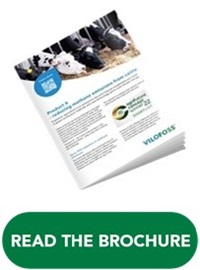Product X - reducing methane emissions from cattle
The universities are also researching how agriculture can become even more climate-efficient in a world where there every day, month, and year are more mouths to feed.
One of the areas where agriculture can really make a difference is by lowering methane emissions from cattle. Research in the area is getting closer to real solutions, which will have a positive effect on agriculture’s overall CO2 emissions. One of the projects that Vilofoss has been working intensively on together with other actors is Product X.
Up to 30% reduction in methane emissions
Product X is a substance that can be added to cattle feed and inhibits the production of methane. Several tests carried out at Aarhus University in Foulum, Denmark show that adding Product X to the feed can slow down the formation of methane in cattle, and thus reduce methane emissions by up to 30%. 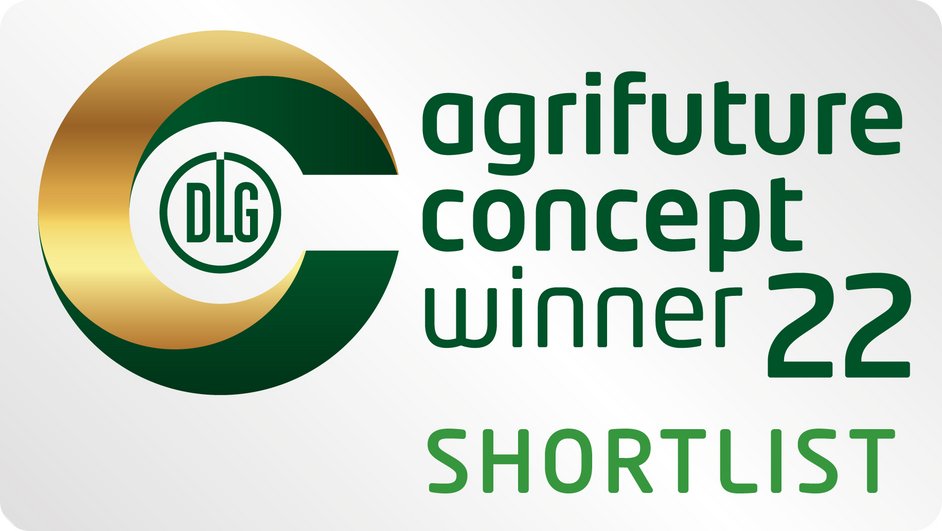
Product X has been nominated at EuroTier 2022 for the Agrifuture Concept Award. A recognition for products that are not yet on the market but show promise and may become important for the future.
Facts about Product X
- Can reduce methane emission from cattle by up to 30%
- Does not affect the feed intake and keeps the milk production stable*
- Works by blocking the methane production without directly altering the cow’s own digestive system
- Has been nominated at EuroTier 2022 for the Agrifuture Concept Award
- Is part of an innovation project called “No Methane”, which aims to make a combined product to reduce emissions of enteric methane by 50%
- Will be tested in large-scale research facilities to obtain solid documentation for EU registration
* Results are from an experiment made on a limited number of cows making responses on feed intake and milk production indicative.
Impact of methane from agriculture
The global greenhouse gas (GHG) emissions from agriculture in 2018 is estimated at 9.3 gigatonnes of carbon dioxide equivalent (Gt CO2-eq) by the Food and Agricultural Organization of the United Nations1. The European agriculture is responsible for 0.85 Gt CO2-eq, whereas 49% of the GHG emissions are caused by enteric methane emissions2.Ruminant livestock alone produces globally about 2.7 Gt CO2-eq from enteric methane annually, which is equivalent to 5.5% of total GHG emissions from human activities3. With methane being one of the most potent short-lived climate pollutants, there is a large potential for immediately reducing climate change and contribute to reducing the environmental impact from food production.
Methane – a by-product from microbial digestion
Enteric methane is defined as a by-product of the natural digestive process in ruminants4. Microorganisms digest feed particles in the rumen, producing short-chain fatty acids and microbial protein as nutrient sources for the dairy cow. By-products from the microbial digestion are used to form methane by another group of microbes called methanogenic archaea. So, the methane causing a large environmental impact is not produced by the cow itself but by the microorganisms living off by-products from other microbial life. This makes it possible to target the microorganisms without directly altering the cow’s own digestive system. Product X can inhibit these archaea in producing methane.
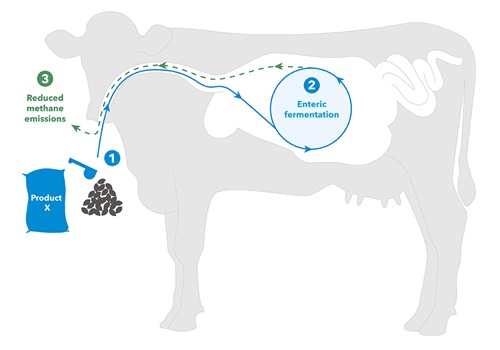
Figure 1.
- Feed added Product X
- Microorganisms degrade the feed
- Product X reduces the methane emissions
The organizations behind Product X
Product X was first tried in lab-scale experiments at University of Copenhagen, where researchers found the potential of reducing methane production from archaea. This initiated an innovative collaboration between university scientists and private companies.
Product X is part of an innovation project called “No Methane”, aiming to make a combined product which reduces emissions of enteric methane by 50%, where Product X is a key part of the reduction. This project is a collaboration of companies, ranging from suppliers of feedstuffs, the processing of animal products cooperatively owned by farmers as well as universities and research institutions. They represent the whole supply chain and the interests of farmers.
First tests of Product X show promising results
The first laboratory tests of Product X showed great ability to reduce methane emissions, with effects depending on the concentration of the compound. To understand the effects of Product X on the digestive system, health, and production status of the dairy cow, research in the “No Methane” project was made by Aarhus University and University of Copenhagen. During and after this research, Vilofoss has been developing administration methods and recommendations for daily intake of Product X for an optimal reduction in methane emissions. These results showed it was possible to reduce methane emissions by 29% per kg of milk (energy corrected) with the cows having a stable feed intake and milk production (Figure 2)5. Analyses of the results showed a need to make adaptations to the active component. Further developments by Vilofoss was done in close collaboration with Aarhus University, where the new adaptations were tested showing promising results.
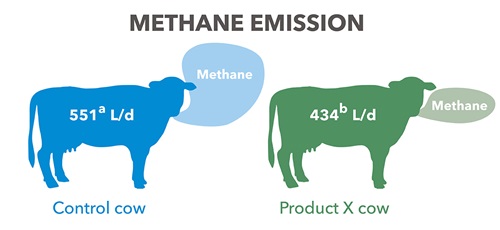
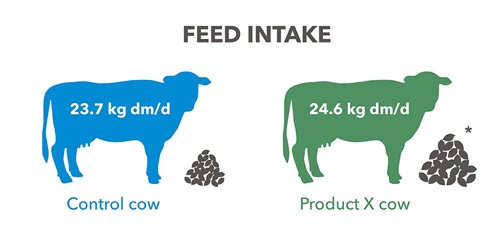
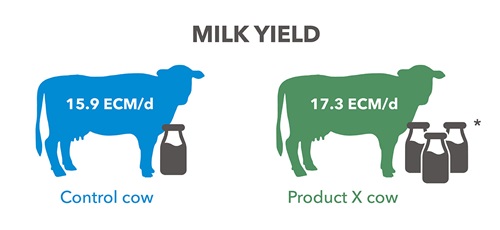
Figure 2.
*Results are from an experiment made on a limited number of cows making responses on feed intake and milk production indicative.
In the near future, Product X will be tested in large-scale research facilities to obtain solid documentation for EU registration of Product X as a feed additive favorably affecting the environmental impact of the animal.
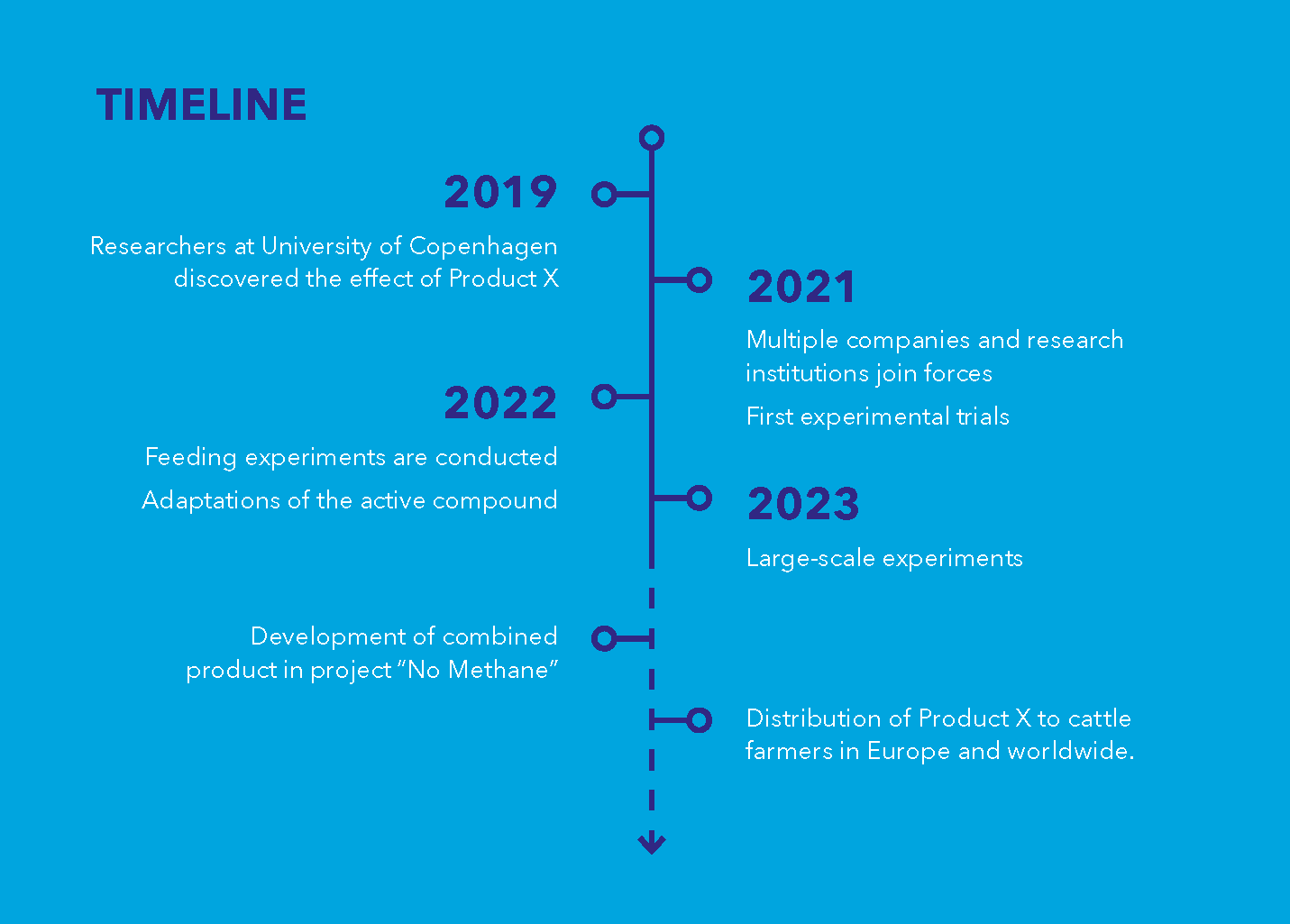
References
1 Food and Agriculture Organization of the United Nations. (2018). Emissions due to agriculture – Global, regional, and country trends 2000-2018. https://www.fao.org/3/cb3808en/cb3808en.pdf
2 Food and Agriculture Organization of the United Nations. (n.d.). [FAOSTAT statistical database]. Retrieved November 3, 2022
3 Food and Agriculture Organization of the United Nations. (2016). Reducing Enteric Methane for improving food security and livelihoods. https://www.ccacoalition.org/en/resources/reducing-enteric-methane-improving-food-security-and-livelihoods
4 Food and Agriculture Organization of the United Nations. (n.d.). Livestock and enteric methane.
https://www.fao.org/in-action/enteric-methane/background/en
5 Nielsen, M. O. (2022). Stof X reducerer køernes metan emission uden forringelse af mælkeproduktion eller fodereffektivitet. Presentation on Fodringsdag 2022, SEGES and Aarhus University. fd22_stof_x_reducerer_koernes_metan_emission_uden_forr_af-maelkeprod_el_fodereff_mette_olaf_nielsen.pdf (landbrugsinfo.dk)


